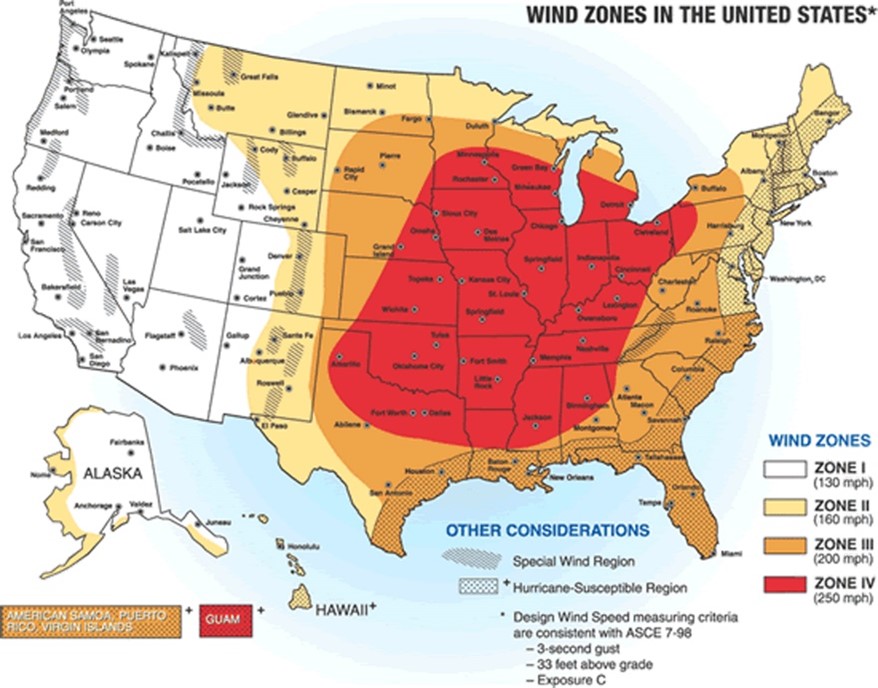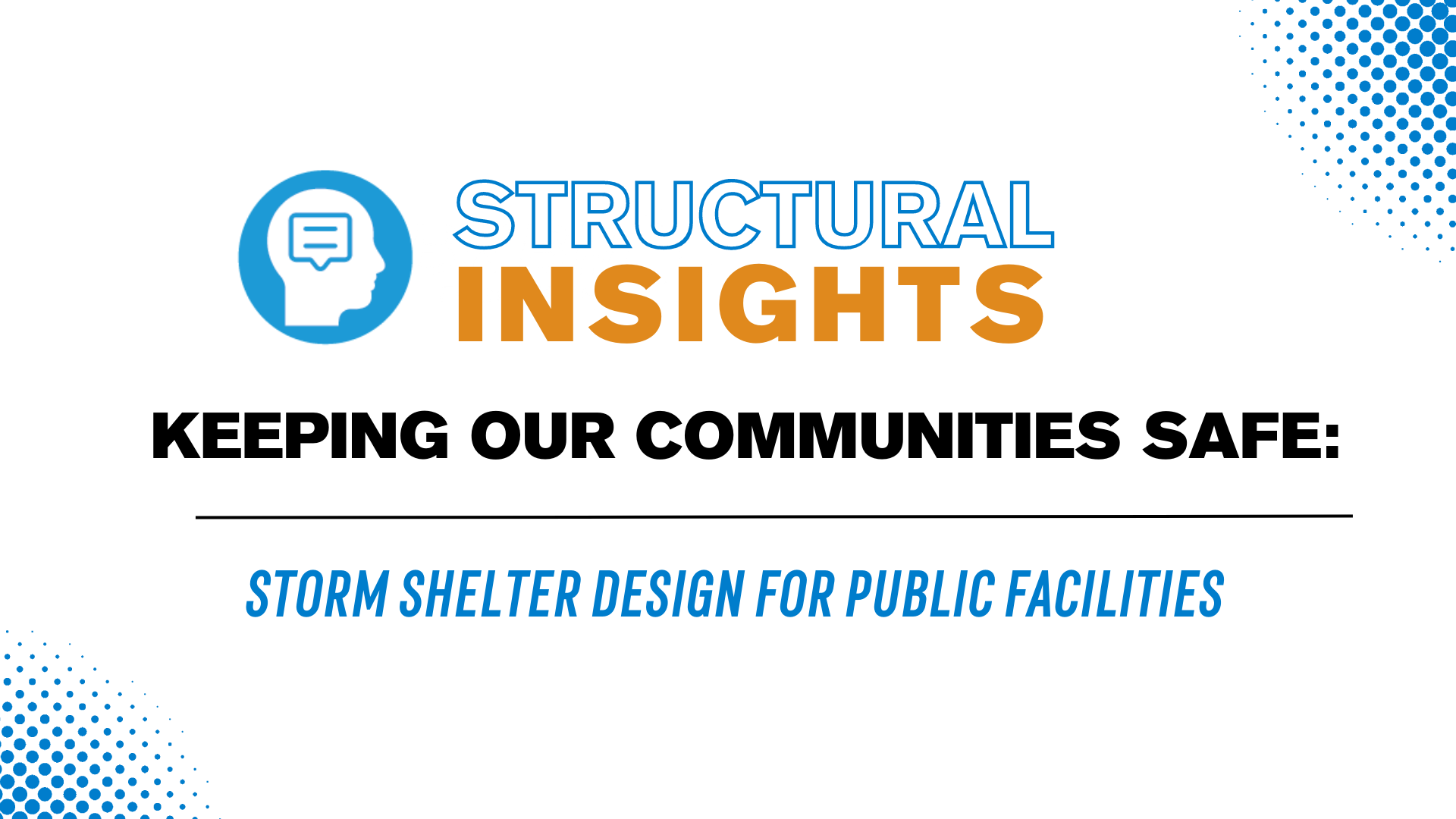Designing storm shelters for education and municipal facilities is an important task that can substantially impact the design, construction, and service life of a building. Beginning with the 2015 International Building Code (2015 IBC) cycle, a storm shelter designed to withstand winds of 250 mph is mandatory for many newly constructed or remodeled public facilities in designated regions across the country.
These storm shelters are intended to provide safety for those inside the building during a tornado or other major storm event. In 2020, Minnesota included this requirement into its building code by adopting the 2018 IBC, which builds on the requirements from the 2015 IBC.
What exactly does the code say about storm shelters in public-facing buildings? Let's look closer.
What the 2018 IBC Code Says
The 2018 IBC references the 2014 ICC 500/NSSA Standard for the Design and Construction of Storm Shelters (ICC 500) and requires certain buildings in Wind Zone IV (as presented in red in the map below) to possess a storm shelter designed to withstand the 250-mph wind loads. The forces from these wind pressures can be as much as 10x that of a typical non-shelter building (referred to as a “host” building in the code) and places a significant demand on the building components such as doors, louvers, and windows, as well as the building envelope that needs to withstand missile impact resistance from flying debris.

Windspeed Map from FEMA 320, similar to ICC-500
But it is not just about structural components surviving the storm. Mechanical, electrical, plumbing (MEP), and architectural partners must also design the building to ‘operate’ independently for a period. This includes making provisions for toilets to function, airflow to continue, and emergency power. All these elements must be considered when designing these important storm shelters.
The project architect and end-user must engage a qualified, experienced design team to comply with the code. The right partners will understand the impacts of their work and how it interacts with other disciplines’ work and elevate the design of a functional, cost-effective, and compliant design. Working with the right-fit partner can differentiate between this success and costly mistakes or inefficiencies. The right-fit partner will understand the code, provide sound recommendations and designs, and help the facility owner navigate the complex (and somewhat novel) construction process.
How to Comply With 2018 IBC Code Requirements
As Minnesota adopted the 2018 IBC, it's essential for all project partners to understand these requirements and how the disciplines involved interact with one another to achieve compliance. When constructing a storm shelter, it's crucial to carefully consider the location and construction materials to be used as large shelters can have a substantial impact on project budget and building performance.
As part of an addition or new construction of the facility, it's important to address some key concepts early in design to determine the optimal location and day-to-day function of the storm shelter and how it interacts with the rest of the programmed space. Some of these key design approaches that can streamline design and minimize costs include:
- Locate the shelter in a way where building water service is brought in through the shelter rather than providing a separate dedicate line.
- Locate the shelter to have at least two exterior walls to permit natural ventilation (ideally opposite walls) and reduce the need for emergency power or other MEP systems.
- Structurally separate the storm shelter from the host building.
- Avoid using natural gas-powered equipment for the shelter as the gas meter is typically required to enter the building above grade, outside the shelter itself, but within its own small-scale shelter.
- Avoid having taller “host building” structures that could collapse (in a storm) near the shelter roof.
- Evaluate the feasibility of atmospheric pressure change (APC) venting early in the design.
- Consider providing an aggregate layer under footings to increase sliding resistance.
- Consider using sacrificial parapets that withstand wind events consistent with the design requirements of the “host building” but do not amplify demand placed on the structure during the 250-mph event.
- If the shelter is an addition to an existing building, locate the shelter 10-15 feet from the existing structure, avoids costly and challenging foundation tie-in details (Reference details).
Selecting the right structural system for storm shelter design and construction is essential. BKBM’s storm shelter experts, James Dorr, PE, and Matt Ricker, PE, often recommend precast or cast-in-place concrete wall systems, with roof systems comprised of precast concrete or structural steel/joists with composite deck and reinforced concrete slabs.
Another unique requirement related to storm shelters is the ICC 500-required peer review. BKBM performs these reviews and routinely has our work undergo the peer-review process.
Value of a Partner with Right-Fit Experience
When designing storm shelters for any facility, having a partner with the right-fit experience can make all the difference. Not only can the right partner help your project comply with the building code requirements, but they can also provide invaluable guidance on optimizing the design for maximum safety, functionality, and cost-effectiveness.
One study we conducted in partnership with Wold Architects and Engineers and Stahl Construction compared the structural cost of a conventional gym design compared to that same space as a storm shelter and found that the structural component costs more than doubled between the designs. Large storm shelters are an area where small decisions can profoundly impact the project. The results of this study were for structural implications alone, but the MEP systems, hardened doors/windows/louvers, and the revised programming costs associated with incorporating bathrooms into this space added to these costs. This study demonstrates how important it is to approach storm shelter design with a multi-discipline mindset, as small decisions can have large ripple effects on costs and functionality.
With nearly 20 design professionals who have contributed to the structural and civil design of storm shelters following the requirements of ICC 500, BKBM understands the process for designing storm shelters that creates efficiency, deploys construction-friendly standardized details, and utilizes efficient design procedures. Our experience has enabled us to gain insight into these complex systems beyond just being a structural consultant; our approach delivers the highest quality product and best value to our clients and their partners.
BKBM has recently delivered the following public facilities with storm shelters (among numerous others) to preserve building occupants’ safety:
White Bear Lake Area High School
- Shelter 1: 16,000 SF, two levels, retaining earth on two sides
- Shelter 2: 9,000 SF with adjacent collapse hazard
Rogers High School
- Primary shelter: 27,500 SF, two levels
- Shelter for utility connections: 20 SF
North St. Paul High School
- 22,000 SF, three levels
Owatonna High School
- 16,800 SF with adjacent collapse hazard
- Supporting 6,400 SF host building
Tartan High School
- 20,500 SF, two levels, retaining earth on three sides
- Constructed in two phases
Anoka County 911 Center
- 2,900 SF with adjacent collapse hazard
Minnesota State Emergency Operations Center
- 2,700 SF with adjacent collapse hazard
Otsego Middle School
- Primary shelter: 16,000 Sf
- Shelter for utility connections: 70 SF
Partner with a firm with the right-fit experience and the expertise to design a storm shelter that will serve your facility during even the most severe weather events.
BKBM’s Storm Shelter Design Leaders
James Dorr, PE, has worked with BKBM for over a decade and is highly experienced in designing and constructing education and municipal facilities. At BKBM, he has worked on scores of buildings and led the design and construction of over a dozen storm shelters across Minnesota. He has become a respected name in the industry and is committed to helping his clients to find cost-effective solutions to their engineering and construction challenges.
Matt Ricker, PE, leads BKBM’s Educational and Municipal design markets, emphasizing quality and excellence. With 20+ years of experience in the engineering industry, Matt has a strong background in structural engineering and expertise in the design of storm shelters. His commitment to excellence has been highlighted by his contributions to the design or oversight of more than 20+ storm shelters throughout the region. Matt has a passion for engineering and provides knowledge and leadership for all design teams.
Have a question about your design project? Do not hesitate to contact us; we are here to help.
Building relationships, communities, and sustainable projects—Discover the power of BKBM's Structural Engineering approach today.
As a Minneapolis-based Civil Engineering firm, the best engineering happens when the professionals at BKBM converse with our clients, listening and understanding their project needs and requirements. That's why we work hard to build strong relationships that will enhance our understanding of how our work fits into the broader context of society. With every project, we aim to create something that makes the world a better place; that's why we strive to engage in sustainable and collaborative practices that benefit not only our clients but the environment and people interacting with our projects. BKBM has offices located in Minneapolis, Minnesota, and Denver, Colorado.


